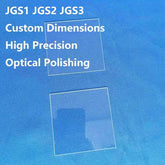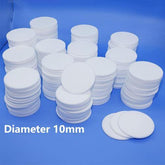The role of sapphire windows in the fields of sensors and detectors
Sapphire windows are widely used in the optical industry. Owing to their unique physical and chemical properties, they have become indispensable protective components for precision devices such as sensors and detectors. They not only safeguard these instruments from external environmental damage but also maintain the stability and accuracy of the optical system by preserving the system’s magnification without alteration. This article aims to investigate the characteristics of sapphire windows and their critical role in sensor applications.
Sapphire windows are characterized by their high hardness and wear resistance, as well as their high light transmittance, which enables the transmission of a wide spectral range from ultraviolet to mid-infrared. Chemical inertness represents a significant advantage of sapphire windows. Notwithstanding the presence of high temperatures, strong acids, and strong alkalis, it exhibits remarkable chemical stability, demonstrating an exceptional resistance to dissolution and chemical reactions. Furthermore, sapphire windows boast exceptional thermal conductivity and electrical insulation properties, thereby ensuring their enhanced versatility in high-temperature environments.
 Sensors and detectors are vital components of modern technology, which are designed for the collection, conversion and transmission of information on various physical quantities, including temperature, pressure, light intensity and magnetic field. These devices are typically engineered to function in harsh environmental conditions, including high temperatures, high pressures and strong radiation. Consequently, the materials used for the protecting windows of these precision instruments must possess high hardness and wear resistance, as well as excellent chemical stability and thermal conductivity.
Sensors and detectors are vital components of modern technology, which are designed for the collection, conversion and transmission of information on various physical quantities, including temperature, pressure, light intensity and magnetic field. These devices are typically engineered to function in harsh environmental conditions, including high temperatures, high pressures and strong radiation. Consequently, the materials used for the protecting windows of these precision instruments must possess high hardness and wear resistance, as well as excellent chemical stability and thermal conductivity.
Sapphire windows are an important component in sensors and detectors. Their primary function is to serve as protective barriers, preventing dust, moisture, corrosive substances and other contaminants in the external environment from contaminating or damaging the sensitive components inside the sensors. Meanwhile, given that the use of sapphire windows does not result in any alteration to the system’s magnification, it is concluded that the measurement accuracy and stability of the sensors and detectors will not be affected. This property has facilitated the extensive utilization of sapphire windows in high-precision measurement instruments, such as optical, infrared, and laser sensors.

Sapphire windows are of particular importance in sensors and detectors due to their unique physical and chemical properties. The material exhibits high levels of hardness and wear resistance, in addition to high light transmittance, chemical stability and thermal conductivity. Meanwhile, since the sapphire window does not change the magnification of the system, it will not affect the measurement accuracy and stability of the sensors and detectors.






